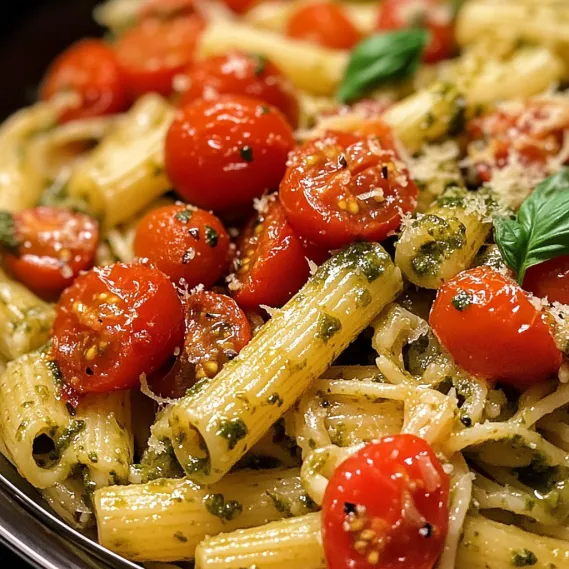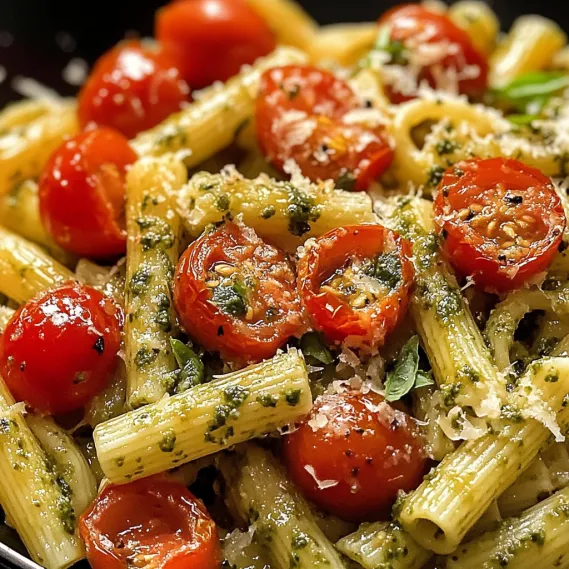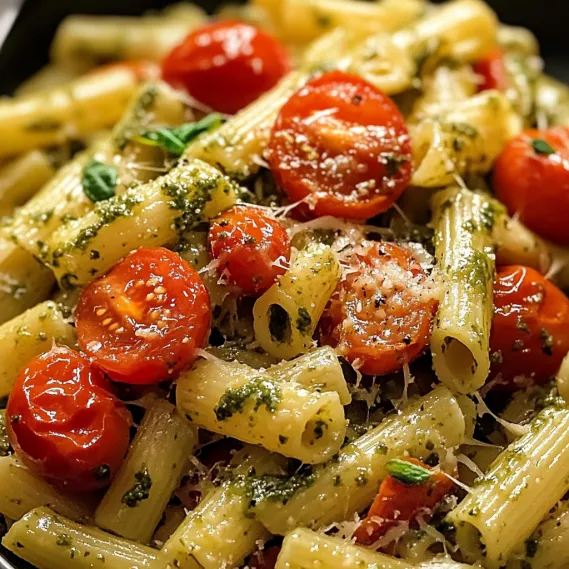 Pin
Pin
This vibrant pesto pasta with roasted tomatoes transforms simple ingredients into a restaurant-worthy meal in just 40 minutes. The sweet caramelized tomatoes perfectly complement the herby pesto-coated pasta, creating a symphony of flavors that will make this dish a regular in your dinner rotation.
I first made this recipe when my garden basil was threatening to take over my herb patch. The combination was so outstanding that it's now my go-to dish whenever I'm entertaining last-minute guests who deserve something special without hours of kitchen work.
Ingredients
- 12 oz pasta: preferably rigatoni to catch the sauce in its ridges
- 2 cups fresh basil: bright green leaves will give the most vibrant flavor and color
- ½ cup pine nuts: toast them lightly for enhanced nutty flavor
- 3 cloves garlic: one for pesto plus two for roasting with tomatoes
- ½ cup freshly grated Parmesan cheese: avoid pre-grated for best flavor
- ½ cup plus 1 tbsp olive oil: use a good quality extra virgin for the pesto
- 2 cups cherry tomatoes: look for firm tomatoes with vibrant color
- Salt and pepper: for seasoning throughout the cooking process
Step-by-Step Instructions
- Roast the Tomatoes:
- Preheat your oven to 400°F. Halve the cherry tomatoes and arrange them cut-side up on a baking sheet. Drizzle with olive oil and season generously with salt and pepper. Add whole garlic cloves scattered among the tomatoes. Roast for 20-25 minutes until the edges begin to caramelize and the tomatoes release their juices. The slow roasting concentrates their natural sweetness while adding a subtle smoky dimension.
- Prepare the Pesto:
- While tomatoes roast, combine fresh basil, pine nuts, garlic and Parmesan in your food processor. Pulse a few times to break down the ingredients before slowly drizzling in olive oil with the machine running. Continue processing until you achieve a smooth but slightly textured consistency. The pesto should be vibrant green and aromatic. Taste and adjust seasonings as needed.
- Cook the Pasta:
- Bring a large pot of water to a rolling boil. Add a generous amount of salt until the water tastes like the sea. Cook pasta according to package directions until just al dente. Before draining, reserve half a cup of the starchy pasta water. This cloudy water contains starches that will help the pesto cling to the pasta while creating a silkier sauce.
- Combine Everything:
- Return the drained pasta to its pot while still hot. Immediately add the freshly made pesto and toss thoroughly. The heat from the pasta will gently warm the pesto and release its aromatic oils. Add splashes of reserved pasta water as needed to loosen the sauce if it seems too thick.
- Finish the Dish:
- Gently fold in the roasted tomatoes, being careful not to crush them. The tomatoes should remain somewhat intact to provide bursts of concentrated flavor with each bite. Transfer to serving bowls and garnish with extra basil leaves and Parmesan shavings if desired.
 Pin
Pin
The quality of your olive oil makes a significant difference in this recipe. I splurge on a bottle of peppery extra virgin olive oil specifically for making pesto. My grandmother taught me that the oil is the canvas that carries all the other flavors, so it should never be an afterthought.
Make It Your Own
This recipe welcomes creative variations based on what you have available. You can substitute half the basil with baby spinach for a milder flavor profile that still maintains the vibrant green color. The pesto also works beautifully with arugula for a peppery twist that complements the sweet roasted tomatoes beautifully.
Storage Tips
Fresh pesto darkens quickly when exposed to air. If making ahead, place plastic wrap directly on the surface of the pesto to prevent oxidation. The assembled pasta dish will keep refrigerated for up to 3 days in an airtight container. The pasta may absorb some of the sauce overnight, so add a splash of olive oil when reheating to refresh the dish.
Perfect Pairings
This pesto pasta works beautifully as a main dish paired with a simple arugula salad dressed with lemon vinaigrette. For wine lovers, a crisp Sauvignon Blanc or light Pinot Grigio complements the herbaceous notes of the pesto without overwhelming the delicate flavors. If serving as a side dish, grilled Italian sausages or a simple roasted chicken make excellent protein companions.
 Pin
Pin
Recipe FAQs
- → Can I make the pesto ahead of time?
Yes, you can prepare the pesto up to 3 days ahead. Store it in an airtight container with a thin layer of olive oil on top to prevent oxidation. Refrigerate until ready to use, then bring to room temperature before mixing with pasta.
- → What pasta shapes work best with pesto?
Shapes that capture the sauce work wonderfully with pesto. Try rigatoni, fusilli, farfalle, or orecchiette. These shapes have ridges or pockets that hold the pesto sauce, ensuring flavor in every bite.
- → Can I substitute the pine nuts in the pesto?
Absolutely! Walnuts or cashews make excellent substitutes for pine nuts. They provide similar richness and texture while being more budget-friendly. Toast them lightly before blending for enhanced flavor.
- → How can I make this dish vegan?
To make this dish vegan, substitute the Parmesan cheese with nutritional yeast or a vegan Parmesan alternative. Use about 2-3 tablespoons of nutritional yeast in the pesto for a similar savory quality.
- → Why is my pesto turning brown?
Pesto turns brown due to oxidation when basil is exposed to air. To prevent this, blanch basil leaves briefly in boiling water before making pesto, cover the surface with olive oil when storing, or add a small squeeze of lemon juice to the mixture.
- → What can I serve with this pasta dish?
This pasta pairs beautifully with a simple arugula salad dressed with lemon and olive oil, garlic bread, or grilled vegetables. For protein, consider adding grilled chicken, shrimp, or white beans to the dish.
